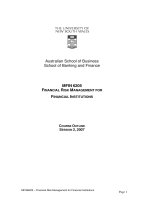Risk Management Financial Management: Cash vs. Accrual Accounting ppt
Bạn đang xem bản rút gọn của tài liệu. Xem và tải ngay bản đầy đủ của tài liệu tại đây (616.87 KB, 5 trang )
1
Financial Management:
Cash vs. Accrual Accounting
Risk Management
E-475
RM5-16.0
10-08
*Professor and Extension Economist, Extension Program Specialist–Economic
Accountability, and Assistant Professor and Extension Specialist–Risk Management,
The Texas A&M System.
Selecting a record-keeping system is an im-
portant decision for agricultural producers. The
system should help with decision making in a
risky environment and calculate taxable income.
Most producers keep their records with the cash
receipts and disbursements method or with an
accrual method.
Either method should be acceptable for
calculating taxable income (except for corpo-
rate taxpayers who have revenues exceeding
$25,000,000). However, it is not acceptable to
keep books throughout the year using one
method of accounting and then convert at
year-end to another method, solely because the
second method might compute taxable income
more favorably.
The main difference between accrual ba-
sis and cash basis accounting is the time at
which income and expenses are recognized
and recorded. The cash basis method gener-
ally recognizes income when cash is received
and expenses when cash is paid. The accrual
method recognizes income when it is earned
(the creation of assets such as accounts receiv-
able) and expenses when they are incurred (the
creation of liabilities such as accounts payable).
Accrual accounting is more accurate in terms
of net income because it matches income with
the expenses incurred to produce it. It is also
more realistic for measuring business perfor-
mance. A business can be going broke and still
generate a positive cash basis income for several
years by building accounts payable (accruing
but not paying expenses), selling assets, and not
replacing capital assets as they wear out.
However, most farmers and ranchers use
cash basis accounting because: 1) the accounting
principles of an accrual system can be complex;
2) given the cost of hiring accountants to keep
their records, accrual accounting is more ex-
pensive; and 3) cash basis accounting is more
exible for tax planning.
Getting the Best
of Both Systems
There is a process by which cash basis income
and expense data can be adjusted to approxi-
mate accrual income. This can be very benecial
to producers, giving them the simplicity and
tax exibility of using cash accounting and the
ability to evaluate prot more accurately. The
process has been recommended by the Farm
Financial Standards Council (FFSC), which is
made up of farm nancial experts from across
the U.S. The only requirements for using this
process are accurate records of cash receipts and
cash disbursements for the period being ana-
lyzed, and complete balance sheets (including
accrual items) as of the beginning and end of
the period.
Danny Klinefelter, Dean McCorkle and Steven Klose*
2
The process yields an “accrual adjusted” in-
come statement. It differs from accrual income in
that inventories may be valued at their current
market value rather than their cost, and work in
process (e.g., growing crops) is valued by direct
costs only (not including indirect labor and al-
located overhead).
The process for adjusting cash basis income to
approximate accrual income is outlined in Table
1. “Beginning” and “Ending” refer to informa-
tion from the balance sheets as of the beginning
and end of the accounting period.
In order to track the logic behind the cash-to-
accrual adjustment process, consider the follow-
ing example of a cash-to-accrual adjustment on
grain sales.
Table 1. Adjusting cash basis records to approximate
accrual basis records.
Cash basis Adjustments to cash basis
Equals accrual
basis
Cash receipts
– Beginning inventories
+ Ending inventories
– Beginning accounts
receivable
+ Ending accounts
receivable
Gross revenue
Cash
disbursements
– Beginning accounts
payable
+ Ending accounts
payable
– Beginning accrued
expenses
+ Ending accrued
expenses
+ Beginning prepaid
expenses
– Ending prepaid
expenses
+ Beginning supplies
(fuel, chemical, etc.)
– Ending supplies
+ Beginning investment
in growing crops
– Ending investment in
growing crops
Operating
expenses
Depreciation
expense
No adjustment made (see
Note 1)
Depreciation
expense
Cash net
income
(pre-tax)
Accrual
adjusted
net income
(pre-tax)
Table 2.
Cash receipts from grain sales this year
$150,000
less: Beginning grain inventory (produced
in prior year)
–$40,000
plus: Ending grain inventory (current year
production
not sold yet)
+$28,000
equals: Accrual grain revenue (approximate
value of current year production)
$138,000
Table 3.
Cash disbursements for interest paid this year
$36,000
less: Beginning accrued interest (interest
owed but not paid in prior year) – $9,000
plus: Ending accrued interest (interest owed
but not paid in current year) + $7,000
equals: Accrual interest expense (approximate
cost of borrowed funds in current year $34,000
Cash basis Adjustments to cash basis
Equals accrual
basis
Cash income
& Social
Security
(S.S.) taxes
– Beginning income taxes
and S.S. taxes payable
+ Ending income taxes
and S.S. taxes
– Beginning current
portion of deferred tax
liability
+ Ending current portion
of deferred tax liability
(see Note 2)
Accrual
adjusted
income
taxes and
S.S. taxes
Cash net
income
(after-tax)
Accrual
adjusted
net income
(after-tax)
Note 1: Because depreciation is a noncash expense, technically it
would not be reflected on a cash basis income statement. Instead,
the statement would show the cash payments for property, facilities
and equipment rather than allocating the cost of the asset over its
useful life. However, because the Internal Revenue Code requires
capital assets to be depreciated, even for cash basis taxpayers, the
common practice is to record depreciation expense for both cash
basis and accrual basis income accounting.
Note 2: It is possible to have an income tax and Social Security tax
receivable (refund due) or a deferred tax asset. In these instances
the sign (+/-) of the period would be reversed when making the
accrual adjustments.
Consider a second example of an expense
adjustment for accrued interest.
3
The same logic applies to the cash-to-accrual
adjustment for other accrual items. The rule to
remember when making the adjustment is that
an increase (beginning to ending) in an accrual-
type asset item will cause net income to increase,
while an increase in an accrual-type liability
item will cause net income to decrease.
Review the example income statements for
Cash Grain Farms (Table 4) to see the differences
between statements based on accrual-adjusted
information and statements based on cash ac-
counting.
Comparing Cash Basis to
Accrual-Adjusted Basis
Cash Grain Farms (Table 4) appears to be
moderately protable on a cash basis. However,
after adjusting the cash basis income statement
Table 4. Income statements: cash basis (left) and accrual-adjusted basis (right).
Cash Grain Farms (cash)
Year ending December 31
Cash Grain Farms (accrual)
Year ending December 31
Receipts
Cash grain sales
Government program payments
Total cash receipts
$150,000
$25,000
$175,000
Revenues
Cash receipts from grain sales
Change in grain inventory
Government program payments
Change in accounts receivable
Gross revenues
$150,000
+ $20,000
$25,000
+ $5,000
$200,000
Expenses
Cash operating expenses
Interest paid
Total cash expenses
Depreciation
Total expenses
$85,000
$37,000
$122,000
$27,000
$149,000
Expenses
Cash distributions for operating expenses
Change in accounts payable
Change in prepaid expenses
Change in unused supplies
Change in investments in growing crops
Depreciation
Total operating expenses
$85,000
– $12,000
+ $1,000
– $2,000
– $4,000
– $27,000
$95,000
Net farm income from operations (cash basis)
Gain/loss on sale of farm capital assets
Net farm income, before tax (cash basis)
Income taxes & S.S. taxes paid
Net farm income, after tax (cash basis)
$26,000
$0
$26,000
$8,000
$18,000
Interest paid
Change in accrued interest
Accrual interest expense
Total expenses
Net farm income from operations
Gain/loss on sale of farm capital assets
Net farm income
Income taxes & S.S. taxes paid
Change in income taxes & S.S. taxes payable
Changes in current portion of deferred taxes
Accrual income taxes & S.S. taxes
Net farm income, after tax (accrual basis)
$37,000
– $2,000
$35,000
$130,000
$70,000
$0
$70,000
$8,000
+ $3,000
+ $13,000
$24,000
$46,000
Remember, because the IRS requires capital assets (machinery, equipment, buildings, etc.) to be depreciated over the useful life of the assets,
the common practice, even with cash basis accounting, is to record a depreciation charge. Therefore, there is no difference in the way
depreciation is handled between cash and accrual accounting systems.
to approximate an accrual basis income state-
ment for the same period, net income after tax
increased from $18,000 to $46,000. Because of
the accrual adjustments, gross revenues were
greater by $25,000 (from $175,000 to $200,000),
while total expenses were less by $19,000 (from
$149,000 to $130,000). However, because of the
accrued and deferred income taxes, the expense
for income taxes is increased by $16,000 (from
$8,000 to $24,000).
After making the accrual adjustments to the
income statement, Cash Grain Farms was shown
to be more protable than had been portrayed by
the cash basis method of accounting. The more
critical situation would occur if the accrual-ad-
justed net income showed the business to be less
protable than the producer may have been led
to believe by relying solely on cash basis income
statements.
4
Table 5. Net changes in noncash transactions.
End year Net change
Inventories
Grain
60,000 80,000 +20,000
Supplies purchased
8,000 10,000 + 2,000
Investment in
growing crops
16,000 20,000 + 4,000
Accounts
receivable
22,000 27,000 + 5,000
Prepaid expenses
4,000 3,000 – 1,000
Accounts payable
17,000 5,000 –12,000
Accrued interest
23,000 21,000 –2,000
Income taxes and
S.S. taxes payable
6,000 9,000 +3,000
Current portion
of deferred tax
liability
21,000 34,000 +13,000
Table 6.
Cash Grain Farms
January 1 to December 31
Assets
Cash net farm income (after-tax)
$18,000
Increase in inventory
26,000
Decrease in inventory
( ) *
Increase in accounts receivable
5,000
Decrease in accounts receivable
( ) *
Increase in prepaid expenses
Decrease in prepaid expenses
(1,000)
Liabilities
Decrease in accrued interest
2,000
Increase in accrued interest
( ) *
Decrease in accounts payable
12,000
Increase in accounts payable
( ) *
Decrease in income and S.S. taxes payable
Increase in income and S.S. taxes payable
(3,000)
Decrease in deferred tax liability
(13,000)
Increase in deferred tax liability
Accrual adjusted net farm income (after-tax)
$46,000
*The parentheses signify the balance sheet accounts that
decrease true net income. These entries are to be subtracted
when calculating the accrual-adjusted net income from cash
basis income.
As this illustration shows, computing income
on a cash basis can misrepresent true prot-
ability for an accounting period when there is
a time lag between the exchange of goods and
services and the related cash receipt or cash dis-
bursement. Such distortion can be substantially
reduced by also considering the net changes in
certain balance sheet accounts.
A quick way to convert the cash basis net
income of $18,000 to the accrual-adjusted in-
come of $46,000 is simply to add or subtract the
various net changes in inventories, accounts
receivable, accounts payable, and other noncash
transactions that affect the true protability of
the operation. The net changes affecting the true
net income of Cash Grain Farms are shown in
Table 5.
Table 6 presents a standard, simplied format
for converting a cash basis income statement to
an accrual-adjusted income statement using the
net changes in the balance sheet accounts. This
abbreviated format is useful if the objective of
the analysis is only to determine the approxi-
mate level of protability after matching rev-
enues with the expenses incurred to create the
revenues.
In summary, an agricultural producer can en-
joy both the simplicity of cash basis accounting
and the correctness of accrual accounting by:
maintaining complete cash basis income •
(receipts) and expense (disbursements)
records throughout the year;
preparing a complete balance sheet •
(including accrual items) at the beginning
and end of each year, and then making
the simple conversion of the resulting
cash basis net income to determine the
accrual-adjusted net income.
Educational programs of the Texas AgriLife Extension Service are open to all people without regard to race, color, sex,
disability, religion, age, or national origin.
Issued in furtherance of Cooperative Extension Work in Agriculture and Home Economics, Acts of Congress of May
8, 1914, as amended, and June 30, 1914, in cooperation with the United States Department of Agriculture. Edward G.
Smith, Director, Texas AgriLife Extension Service, The Texas A&M System.
Produced by AgriLife Communications, The Texas A&M System
Extension publications can be found on the Web at: .
Visit Texas AgriLife Extension Service at .
Partial funding support has been provided by the
Texas Corn Producers, Texas Farm Bureau, and
Cotton Inc.–Texas State Support Committee.









